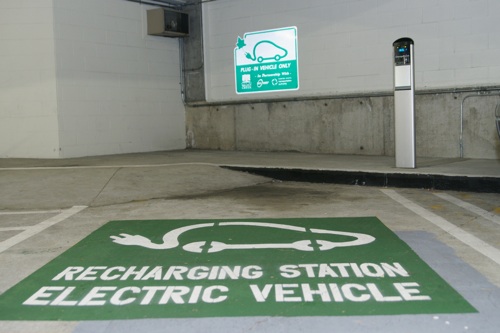Electric car owners need access to electricity – all of us do. Unfortunately there often aren’t enough charging stations to go around, leaving us to either practice good sharing habits, or to replay childhood games equivalent to “hogging the ball.” In other words, some people don’t have any qualm hogging the charging stations, leaving their car plugged in long after it became fully charged.
A couple years ago I wrote a nice piece on charging station etiquette, calling out the importance of “When your electric car is done charging, move it so other electric cars can use the charging station.”
If there were plenty of charging stations, we wouldn’t need to make up rules like this. As it is, the limited number of charging stations mean, for peaceful coexistence between electric car owners, that all of us should share the stations. But we all know that some electric car owners see it differently, and do hog public charging stations.
Squatting, as some call it, at a charging station, when your car is fully charged, prevents others from charging.
It’s clear from observation that some people just don’t get it, and seem happy abusing the system. A year ago I wrote about charging stations owned by the Santa Clara County Water District – a nice installation, with solar panels covering the parking lot, plenty of charging stations, and completely free for anyone to use. What’s happening? Some neighbors are taking advantage of the free electricity, leaving their cars plugged in overnight, even when they have a charging station at home.
The pattern is simple/obvious enough, and it’s compelling to say “oh, look, free electricity” and go for it. But that’s not free electricity. The Water District pays for it, and eventually the rest of us pay for that electricity through our water bills.
The problem is clear, so what’s the solution?
There must either be some enforced limit on the length of time at the charging station, or another mechanism to share the electricity.
Here’s a few ideas I’ve heard of:
- Paying a fee: Some places, configure the charging stations to be “free” for the first hour, then to impose a fee. For example, the Target store in Fremont has an extensive collection of charging stations in the parking lot. Instead of it being completely “free” to use, they’re free for the first two hours after which the user is charged a significant fee. Voila, nobody squats at those charging stations, which is perfect because the stations are so heavily used. The fee encourages users to quickly move their car.
- Timer: Instead of charging a fee, just set up a timer and shut off the charging station after two hours. The car owner will feel encouraged to move their car – or else to game the system by unplugging the car, and plugging it back in to restart the timer?
- Valet’s to move cars: Some parking lots already have a Valet staff to move cars around, so why shouldn’t those people be used to shuttle cars in and out of charging stations?
- Direct communication (e-mail etc) between charging station users: Employees at office parks often set up an email system to inform each other when charging stations become available. This is great way to convey sharing on the personal level.
- Leave nasty notes on offending cars: While the car won’t notice the nasty note, perhaps the human who owns the car will. But will a nasty note encourage that person to share? Or will a kind note, that educates rather than lectures, be a better idea?
- Automatically sharing electricity between charging stations: Maybe humans are incapable of being this kind to each other. The real scarcity isn’t scarce charging stations, but it’s the capacity of the electrical panels. A panel with 200 amps capacity (to pick a number out of thin air) can only service five charging stations (40 amps per charging station). But if the charging stations were controlled by a gizmo for sharing electricity, a charging station occupied by a squatter wouldn’t tie up 40 amps of service panel capacity. Instead, the gizmo would reallocate that 40 amps to another charging station, instead. Unfortunately this idea hasn’t caught on in a big way.
- Highway design could decrease death and injury risk, if “we” chose smarter designs - March 28, 2015
- GM really did trademark “range anxiety”, only later to abandon that mark - March 25, 2015
- US Government releases new regulations on hydraulic fracturing, that some call “toothless” - March 20, 2015
- Tesla Motors magic pill to solve range anxiety doesn’t quite instill range confidence - March 19, 2015
- Update on Galena IL oil train – 21 cars involved, which were the supposedly safer CP1232 design - March 7, 2015
- Another oil bomb train – why are they shipping crude oil by train? – Symptoms of fossil fuel addiction - March 6, 2015
- Chevron relinquishes fracking in Romania, as part of broader pull-out from Eastern European fracking operations - February 22, 2015
- Answer anti- electric car articles with truth and pride – truth outshines all distortions - February 19, 2015
- Apple taking big risk on developing a car? Please, Apple, don’t go there! - February 16, 2015
- Toyota, Nissan, Honda working on Japanese fuel cell infrastructure for Japanese government - February 12, 2015










